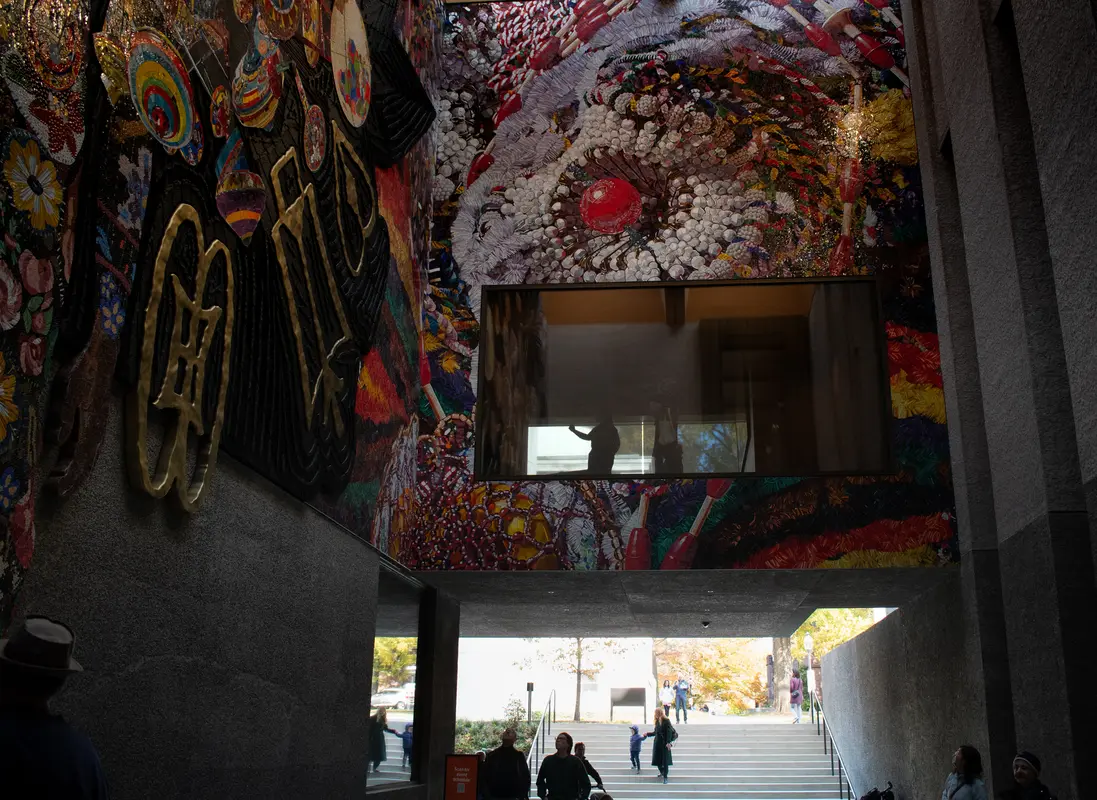
24 Hours in the Art Museum
In 1755, N.J. colonial governor Jonathan Belcher gifted his
portrait to Princeton. It was hung in the prayer room in
Nassau Hall. In 1777, the contents of the building were
destroyed by fire.
Not to be deterred, the trustees began collecting art again in 1783. But a second fire in 1802 destroyed most of the collection, with Charles Willson Peale's "George Washington at the Battle of Princeton" as one of the only surviving relics.
Shortly after, Professor John Maclean, a member of the Class of 1816, began rebuilding the collection with portraits of the University presidents — an endeavor to which he dedicated the rest of his life. Another fire raged in 1855, but this time, students and town residents were able to save the majority of the collections.
Princeton's first museum opened in 1874 with these collections, displayed together in a dedicated space in Nassau Hall. Just 16 years later, a freestanding museum opened near Prospect House, costing just $40,000 at the start ($90,000 in total, or around $3.2 million today). This museum soon shared its space with the new School of Architecture, as well as the Department of Art and Archaeology, and expanded in 1923 to accommodate the departments.
Since then, McCormick Hall has stood in central campus, with additions and expansions being added to the complex throughout its almost 100-year tenure. The result? "A random and chaotic assemblage of additions in a host of disparate and even jarring historicizing styles," or so predicted Professor Jean Labatut in the 1930s, as Museum Director James Steward wrote in Renaissance: A New Museum for Princeton.
So in 2021, Princeton tore it down. After five years of construction, Steward promises that this building will be "a game changer for our campus, for our town."
To usher in the opening, the Princeton University Art Museum (PUAM) held a 24-hour open house beginning at 5 p.m. on Halloween, welcoming almost 22,000 visitors. The Daily Princetonian was there the whole time, just in case a fire started.
Not to be deterred, the trustees began collecting art again in 1783. But a second fire in 1802 destroyed most of the collection, with Charles Willson Peale's "George Washington at the Battle of Princeton" as one of the only surviving relics.
Shortly after, Professor John Maclean, a member of the Class of 1816, began rebuilding the collection with portraits of the University presidents — an endeavor to which he dedicated the rest of his life. Another fire raged in 1855, but this time, students and town residents were able to save the majority of the collections.
Princeton's first museum opened in 1874 with these collections, displayed together in a dedicated space in Nassau Hall. Just 16 years later, a freestanding museum opened near Prospect House, costing just $40,000 at the start ($90,000 in total, or around $3.2 million today). This museum soon shared its space with the new School of Architecture, as well as the Department of Art and Archaeology, and expanded in 1923 to accommodate the departments.
Since then, McCormick Hall has stood in central campus, with additions and expansions being added to the complex throughout its almost 100-year tenure. The result? "A random and chaotic assemblage of additions in a host of disparate and even jarring historicizing styles," or so predicted Professor Jean Labatut in the 1930s, as Museum Director James Steward wrote in Renaissance: A New Museum for Princeton.
So in 2021, Princeton tore it down. After five years of construction, Steward promises that this building will be "a game changer for our campus, for our town."
To usher in the opening, the Princeton University Art Museum (PUAM) held a 24-hour open house beginning at 5 p.m. on Halloween, welcoming almost 22,000 visitors. The Daily Princetonian was there the whole time, just in case a fire started.
Reporters: Andrew Bosworth, Sena Chang, Victoria Davies, Lucas Escobar, Raphi Gold, Coco Gong, Michael Grasso, Luke Grippo, Leela Hensler, Mackenzie Hollingsworth, Ben Hooper, Lola Horowitz, Elizabeth Hu, Melinda Huang, Vitus Larrieu, Haeon Lee, Lulu Mangriotis, Gavin McLoughlin, Devon Rudolph, Nika Schindler, Cynthia Torres, Ambre van de Velde, Christine Woods, Oliver Wu, Grace Zhao, and Lucy Zschoche
Web Design: Cole Ramer, Yacoub Kahkajian, John Wu, Stephanie Sugandi
Photographers:
Calvin Kenjiro Grover, Katherine Shea, Sierra Sydenham, MC McCoy
5–6 p.m.
5 p.m. — Steward opens the doors to the hundreds
of people lined up outside of the building. Many
are dressed in Halloween costumes, looking to
party the night away surrounded by art.
5:11 p.m. — The galleries are filled with
people; the lines going up and down the stairs
are growing. In the Grand Hall, makeup artists
are painting children's faces.
5:31 p.m. — A family dressed as the Addams
family walks past. They look incredible and are
one of Senior Associate Director for Collections
and Exhibitions Chris Newth’s favourite costumes
so far. There are so many tiny children dressed
up for Halloween as well.
5:40 p.m. — As people enter galleries, they’re
asked to take off their backpacks and put them
over one shoulder. People are also leaving food
and drinks at the entrance of the galleries.
5:45 p.m. — I pet a golden retriever outside
dressed as the cowardly lion. He is drawing a
lot of attention, and he deserves it.
5:53 p.m. — The Modern and Contemporary Pavilion
is popping. People like Sonya Kelliher-Combs’s
“Idiot Strings: The Things We Carry” (2017) in
the middle. I’m sitting in the Hans and Donna
Sternberg viewing room. I feel very calm right
now.
5:59 p.m. — Right in the lobby, local resident
Ashley Richardson and Assistant Professor of
Molecular Biology Kai Mesa sport eye-catching
Jackson Pollock-inspired costumes with splatter
paint, a unique, on-theme outfit for the
museum's opening. "The energy feels high,"
Richardson remarks.
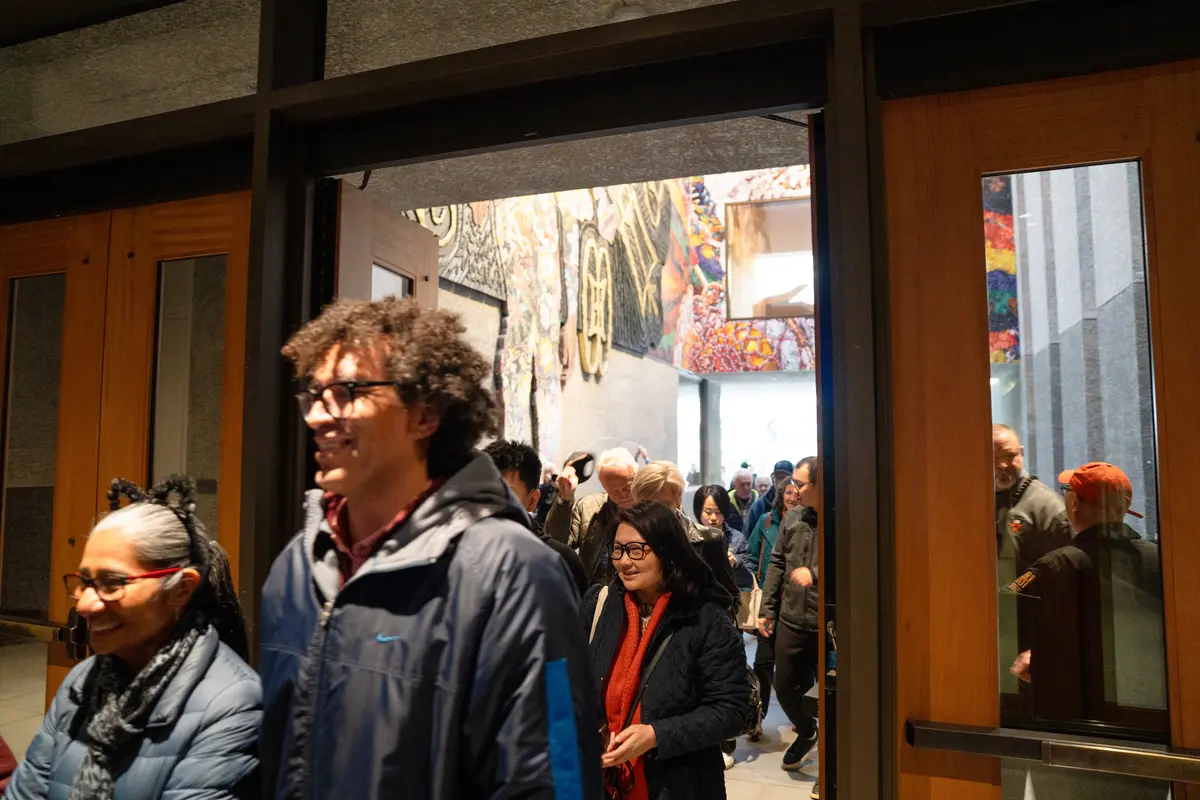
6–7 p.m.
6:15 p.m. — A couple talks about how they tried
to come here on their first date four years ago
and arrived at the early stages of construction.
They’re back for a second chance. That’s
commitment. “We tried to go to the Princeton Art
Museum on our first date four years ago, and it
was a hole in the ground,” says Daisy Eckman, a
N.J. local. “We’re making it official and coming
back to see the art museum.”
6:20 p.m. — In the viewing room connected to the
Modern and Contemporary art section, three
townspeople critically analyze Jane Irish’s
“Cosmos Beyond Atrocity” (2024). The painting is
embedded in the ceiling. “The different
perspectives are being broken. It’s
captivating,” says Matthew Feuer, a Princeton
resident. He’s been waiting five years for the
museum to reopen.
6:46 p.m. — A coven of witches is tearing up the
dance floor.
6:49 p.m. — Six students dressed as Louvre
robbers are giggling at the back entrance. Did
they steal the crown jewels of the Princeton
University Art Museum?

7–8 p.m.
7 p.m. — A costume contest begins, inviting
patrons to dress up as one of 15 objects on
display in the museum. Over 30 contestants
competing across two age brackets demonstrated
their costumes to hundreds of onlookers over the
course of an hour in the Grand Hall.
7:14 p.m. — A baby comes dressed as Viktor
Schreckengost’s Jazz Bowl.
7:18 p.m. — “No contestant will be disqualified
for declining to wear their costume,” says
Steward, in regards to another baby contestant
protesting wearing her costume.
7:46 p.m. — “The costume contest was [created]
because there was so much creativity that sort
of came out during those dark [COVID] times, so
people tried to reimagine their favorite works
of art translated into something they could
wear,” Steward says. The first-place winners in
the adult category are Teddy Knox GS and his
friend Tess Teodoro, who portrayed Leonora
Carrington’s “Twins.” “I planned my semester
around this, frankly,” Teodoro says. “We felt
this [painting] was a natural fit because we
knew we wanted to do a costume together, and
there were two figures in it,” Knox says. “The
more we looked into it, the more we got excited
by the painting and the story of the artist.”
Their costumes included hand-painted renditions
of the twins’ faces, which were stretched across
frames fashioned from old baby wipe boxes.
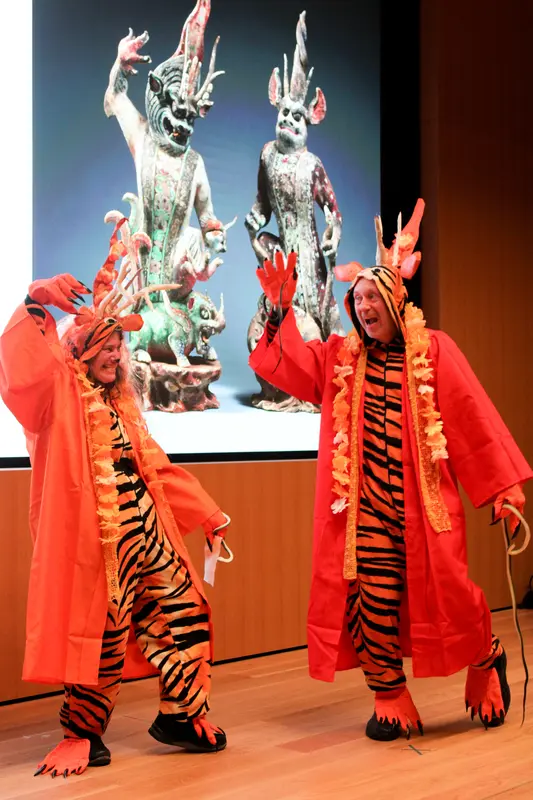
8–9 p.m.
8:05 p.m. — “I am really impressed with how
large the second floor is because it holds so
much art up there,” says Christina Li ’26.
8:40 p.m. — There’s a woman carrying a dog who’s
dressed as an avocado.
8:42 p.m. — There are a lot of groups of crayons
— apparently there are 40 of them? They’re all
walking around in small groups of three to four.
They say a short green crayon organized all of
this, but we can’t find her.
8:49 p.m. — There’s a group of children sitting
on the floor outside the restaurant, going
through their buckets of candy, looking bored
out of their minds. I wish I were
trick-or-treating.
8:51 p.m. — Alyia Frisby, a student at the
College of New Jersey, thought that the decision
to host the 24-hour open house over Halloween
was “the best idea they could have had.”
8:58 p.m. — The elevator is out of order. I walk
past on the second floor. There are around six
people in wheelchairs or with strollers waiting
for the elevator to work again. Visitors are
waiting in line to go up or down the stairs.

9–10 p.m.
9:05 p.m. — Tavia Whitney ’93, who was in town
for her son’s soccer senior weekend, describes
the transformation from the old museum as
“mind-boggling.” “We’ve been coming to visit for
so many years and seeing it under construction,”
she says. “So far, I’m just blown away.”
9:28 p.m. — Students standing outside of the
restaurant on the top floor of the museum are
surprised to see that the mocktails are not free
and actually cost $9.
9:48 p.m. — “A lot of people tonight?” I ask the
Public Safety (PSafe) officer posted at the
bottom of the staircase. “Oh, only about five or
six thousand,” he jokes. He sounds giddy.
9:59 p.m. — I am dressed up as Snoopy in line
for drinks at Mosaic Restaurant — where I have
no intention of actually buying the $9 mocktail
— and I shake hands with another Snoopy. “Nice
to meet you, Snoopy,” we say to each other. His
costume is definitely better thought-out than
mine; plus, he has Woodstock to go along with
him, and I’m currently solo.

10–11 p.m.
10:09 p.m. — Many people at the art museum are
dressed as Louvre thieves. Two of them have been
going around pretending to steal art, taking
selfies with paintings, and positioning
themselves as if about to steal them, arms
outstretched toward the artwork.
10:21 p.m. — I almost crash into a Piet Mondrian
painting — oh wait, that’s a man wearing a
jacket with the iconic red, blue, and yellow
composition.
10:43 p.m. — Halfway up the staircase to the
second floor, I find Camryn Phillips GS, who
leans on the railing, quietly sketching the
capital and shaft of a column. She’d helped out
with Sky Gazing an hour earlier, seeing Saturn
and the moon. Phillips, who grew up around DC,
spent lots of time sketching in the National Art
Gallery and other museums. “I was very friendly
with the guards at the Smithsonian,” she says.
“I [thought] I should do this for old times’
sake,” she adds. “I don’t get to do it very much
these days.”
10:54 p.m. — A young woman walks by, clad in a
black dress with flames of red, gold, and yellow
spiraling up at the hems and a wooden pole at
her back.
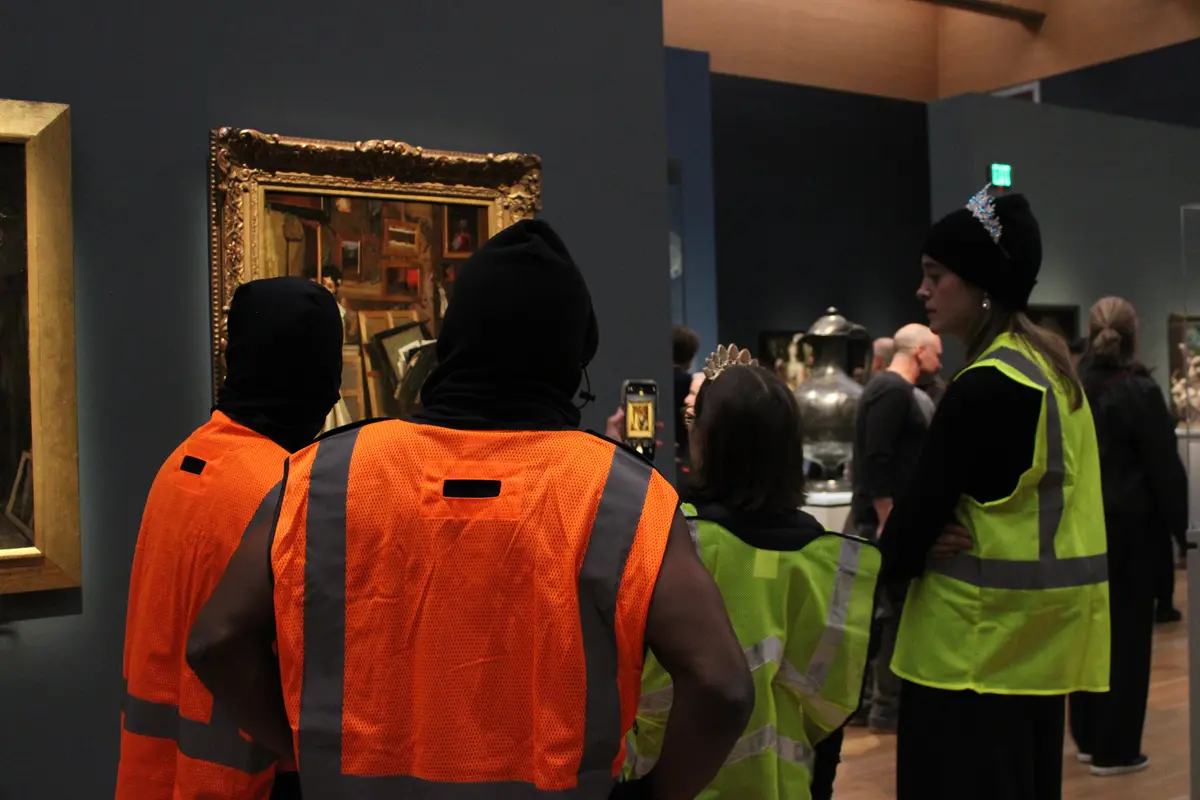
11 p.m.–midnight
11:09 p.m. — Although the disco is “silent” and
everyone has rainbow-colored headphones on, the
crowd synchronizes perfectly with their a
cappella version of “Mr. Brightside.”
11:22 p.m. — As I walk around the second floor,
a group of four girls dressed as Disney
princesses asks me to take photos of them.
11:59 p.m. — I’ve counted seven different people
wearing tiger costumes.
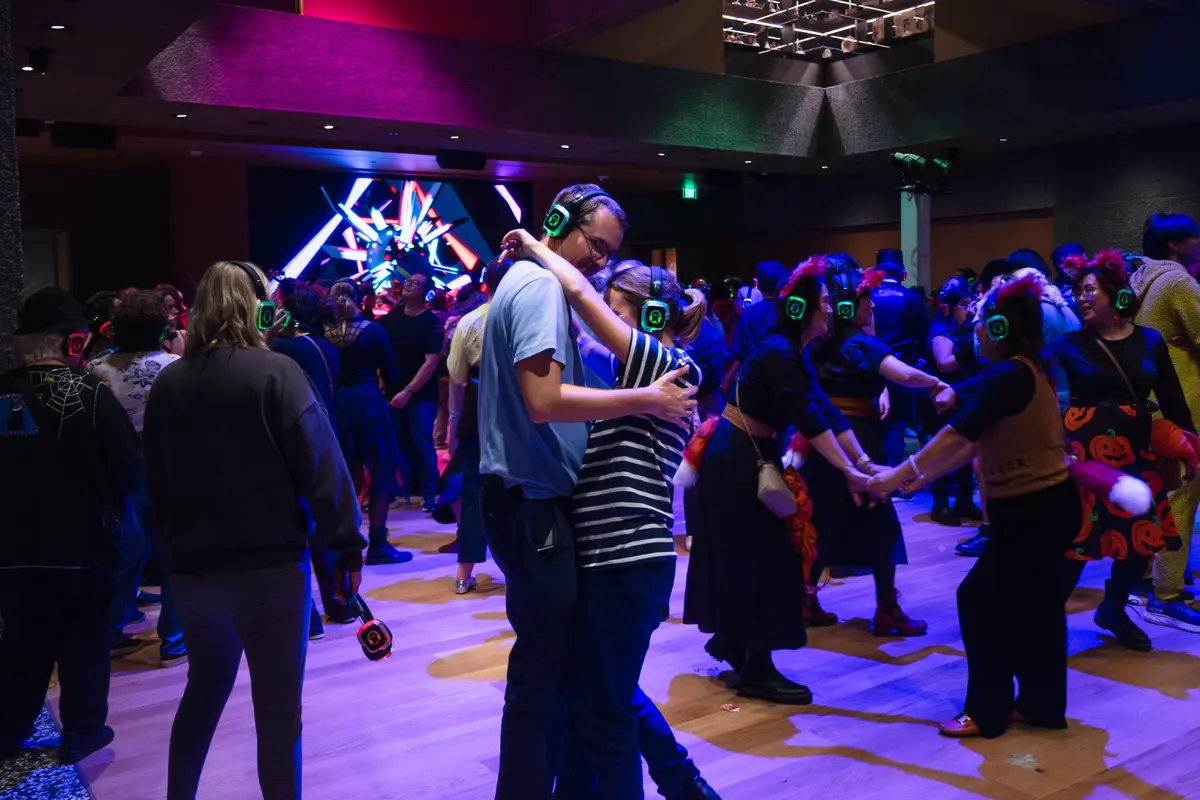
Midnight–1 a.m.
Midnight — The silent disco has come to an end.
Everyone is slowly filing out of the grand hall,
many heading upstairs to the galleries. The
Toshiko Takaezu exhibition is buzzing, but the
demographic has changed in the last two hours.
The average age has approximately halved, but
some fluctuation is expected as students head
out and other folks head to bed. This is the
first time tonight where the only event is
dreaming and drawing. Late-night trivia starts
in 90 minutes.
Stephen Kim, Associate Director for
Communication & Information, and Newth are
standing strong. Newth is here for another five
hours. It's crazy quiet here now compared to
earlier.
12:19 a.m. — Someone is dressed as the Oval with
Two Points (the statue that serves as the logo
of the Office of the Dean of Undergraduate
Students). Hats off to them.
12:30 a.m. — It’s calm. Loads of people have
left in the last few minutes.
12:50 a.m. — Students seem to be coming in in
groups. This is earlier than I expected
party-goers to arrive.

1–2 a.m.
1:20 a.m. — I find Hannah Riggins ’27 and Olivia
Martin ’27 on a bench in a corner. They say they
came here tonight for “introspective
conversation, a way to escape from the chaos of
the Street.” “We were trying to force the night,
and it just didn’t pan out,” Riggins says. “The
environment wasn’t conducive to reflection,”
Martin adds.
1:30 a.m. — “I actually was able to take a tour
of the building while in construction,” Houston
Landis says. Landis wasn’t involved in the
construction of the museum, but he does a lot of
construction work for the University.
1:35 a.m. — Despite the massive night out on
Prospect Avenue, no major incidents with drunk
students seem to have occurred so far. “I was a
bit worried, because I was like, ‘everyone’s
just going to come straight from the Street.’
But we’re all very respectful,” says Iman Bedru
’28. “Seeing everyone in their costumes is kind
of funny, the contrast between us all [coming]
from the Street and then looking at the art, but
everyone seems to be appreciating it, and it
seems great.”
1:55 a.m. — I would’ve been three for 29 at
trivia.

2–3 a.m.
2:02 a.m. — There is a copious number of drunk
individuals making their way up the stairs. “You
need a little suspense. You’re looking at the
art, and it’s like: oh, what if this guy knocks
it over? It adds to it,” says Andrew Li ’29.
2:18 a.m. — Three people prance around the
museum’s second floor. William Suringa ’26
carries a camera, filming energetically, as
David Kwon ’26 and Allison Rodrigues ’26
narrate. “In 30 years, when we come back to
Princeton … we’ll see the footage of when we
were 21 years old,” Rodrigues says. “I hope
we’re all still friends then. I think we will
be.”
2:37 a.m. — Late-night trivia winners are
announced in the Grand Hall to a muted but
substantial audience. The first-place team,
“Trivia Crackheads,” tells me they compete
together in the weekly Rockefeller College
trivia.
2:44 a.m. — The screening of “The Grand Budapest
Hotel” finishes in Tuttle Lecture Hall. The room
is nearly full.
2:50 a.m. — Five people remain until the end of
the credits. Shin Cheng, a local resident,
responds when asked why she’s at the museum so
late: “A night at the museum, right?” I see her
again at 3:53 a.m.
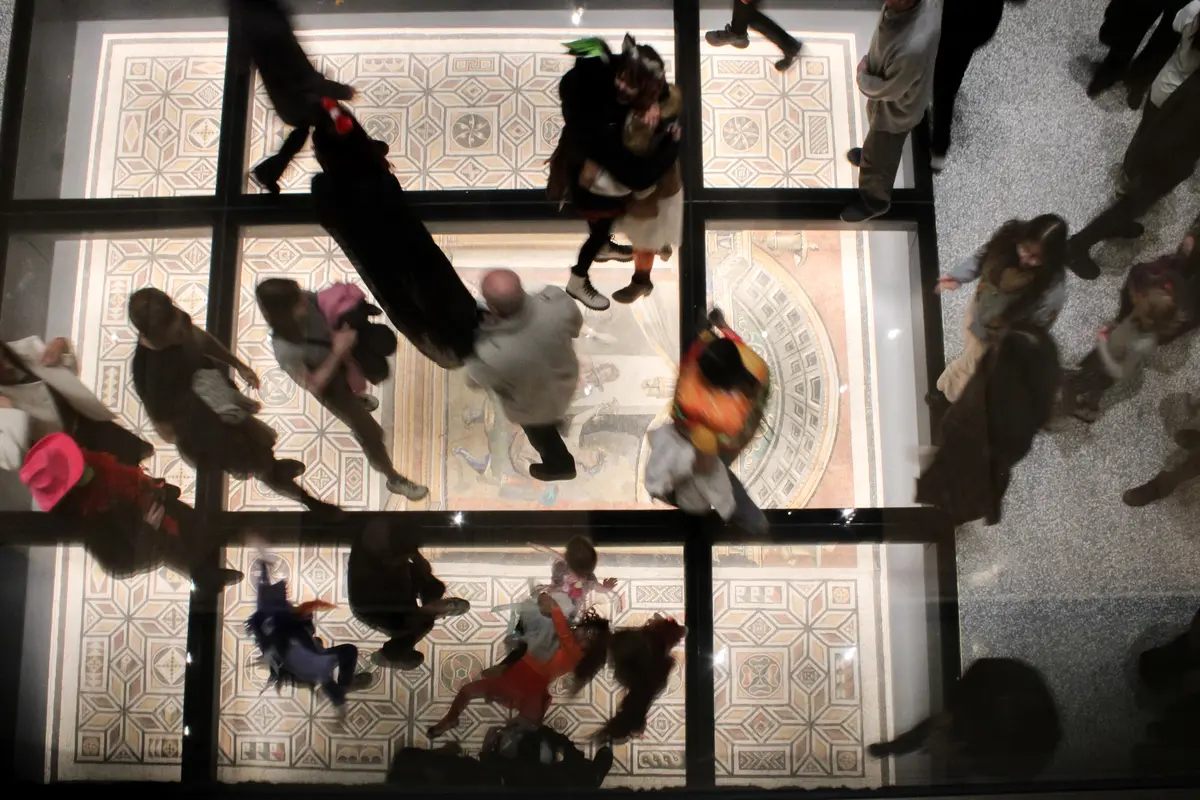
3–4 a.m.
3 a.m. — I’ve spent the last two hours working
in the Loevner Artwalk. Would recommend. I now
return upstairs to almost empty pavilions. Those
remaining are primarily students, although there
are some older folk. At 3 a.m., I cannot explain
why.
3:14 a.m. — A group of five people in costumes
gasp when they see Jean-Michel Basquiat’s
“Notary” (1983). One comes within a fraction of
a centimeter of Morris Louis’s “Intrigue”
(1954). A friend warns: “Watch out, watch out.”
3:20 a.m. — There are still many people in the
museum, despite the late hour. My knees are
sore.
3:33 a.m. — Many drunk people are stumbling
around. The modern gallery is basically empty
except for three people.
3:37 a.m. — Some of the PSafe officers also seem
to be going mad. One just saw me in the viewing
room and went “Oh, hey,” then walked away going,
“Weee weee.” Never have I ever spent a night in
a museum before. There’s a first time for
everything.
3:41 a.m. — Carin Companick, a middle-aged local
resident, strolls around. She says, “I’m a
serious night owl, and I didn’t know when I’d
have an opportunity to browse around galleries
at 3:41 in the morning.”
3:51 a.m. — In the Grand Hall, three students
have fallen asleep on the couches. The room is
mostly empty, but nearby, a man reads the art
museum magazine.
3:57 a.m. — Most rooms now have no or only a few
people in them, but people, many dressed in
costumes, continue to roam.
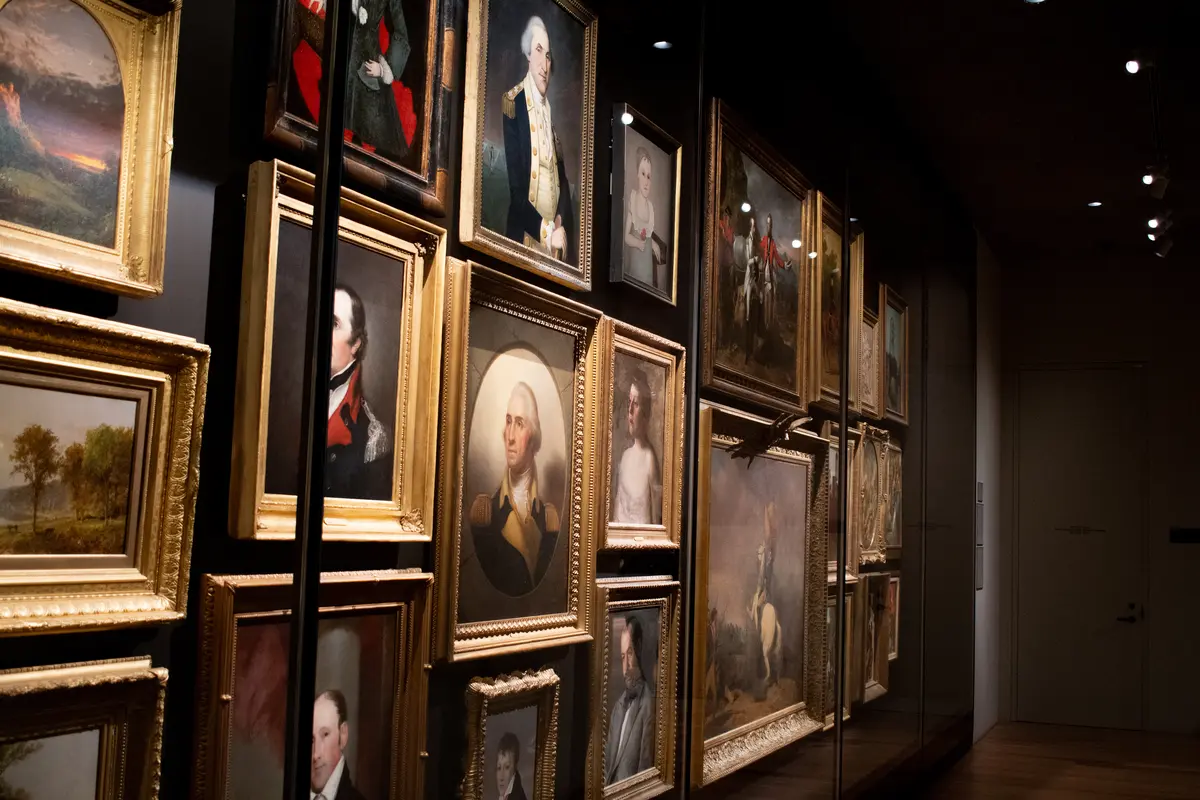
4–5 a.m.
4:12 a.m. — There are few people walking
around each upstairs gallery. There is an
almost library-like quietness to it.
4:28 a.m. — Three of the trivia winners are
still here in costume. “It’s Halloween night.
Everyone’s pretending to be something they’re
not, but art evokes. Art evokes the feeling of
connection with the subliminal that one may
not always find in a typical setting,” says
Alejandra Ramos ’27, one of the winners.
4:28 a.m. — I find Chris Newth again. He has
been awake for 24 hours and at the open house
for nearly 12. His favourite costumes of the
night include contestants in the costume
contest representing Leonora Carrington’s
“Twins” (1997) and a family dressed up as
Cruella de Vil with two dogs — one man and one
baby dressed in Dalmatian onesies. “It’s now
4:30, and we’ve never been empty,” Newth says.
“It was fun just to people watch and see them
interact with the activities and the art and
each other.”
4:33 a.m. — Harry Toung ’78 has been here the
whole time. “I’m just gonna stay as long as I
can stay,” he says. He is an architect here to
“witness the coming to life of this building.”
Some of his friends will join him later in the
day.
4:58 a.m. — The first of the early risers has
arrived. “I just wanted to check it out before
everyone comes in. I’m kind of surprised that
it’s not busy,” says Jacqueline Yang GS, a
first-year Ph.D. candidate in the Art and
Archeology department.
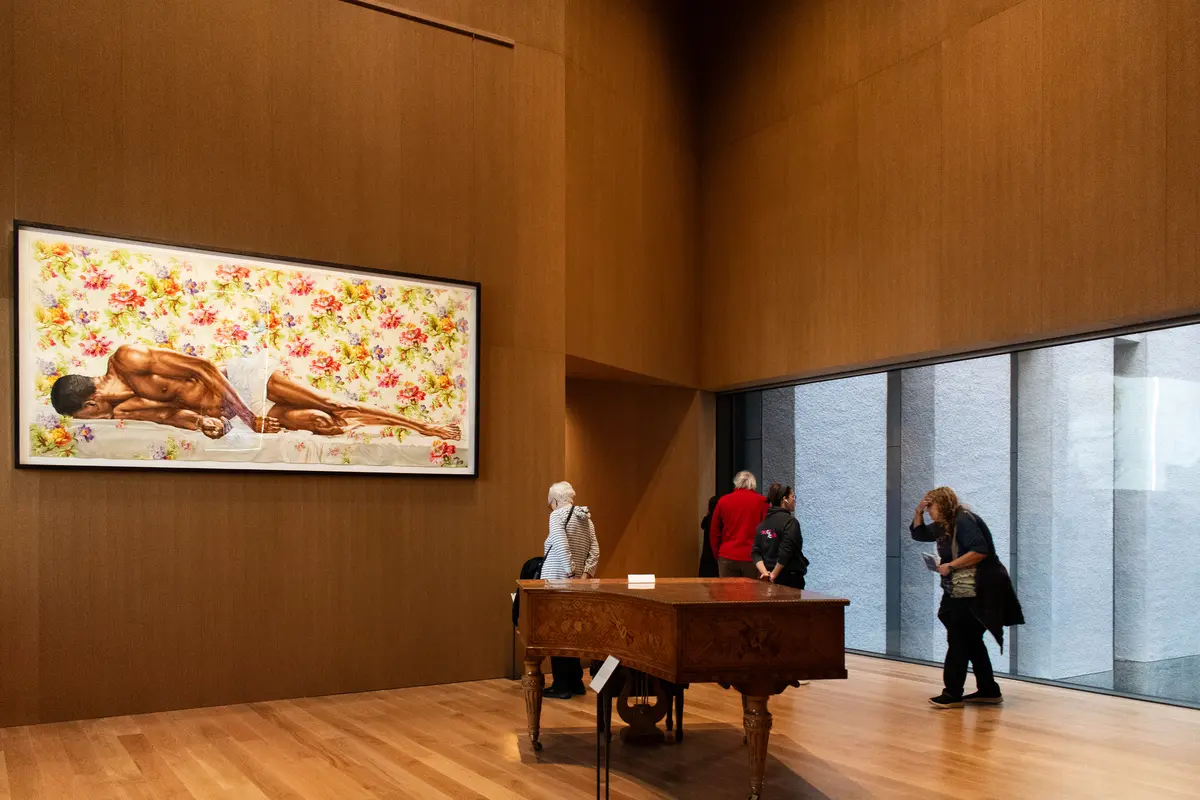
5–6 a.m.
5:18 a.m. — People have started filing back in
again slowly. I think these people have
probably slept. Happy for them. A couple
people remain in their Halloween costumes.
They have not slept.
5:35 a.m. — Workers from facilities are
attempting to clean the art walks.
5:42 a.m. — I’m starting to see a few new
faces, including a family with two young
children.
5:59 a.m. — Marco Wheeler ’29 and Corbin
Mortimer ’27 say they have already been here
for three to four hours. They came with a
group of friends after a Halloween party, but
now it is just the two of them in the “serene
and peaceful, very quiet” museum, as Wheeler
said. They’ve been going back to the modern
and contemporary pavilion and the Pacific
Northwest Indigenous art. Wheeler is a
contributing Copy editor for the ‘Prince’;
Mortimer is an associate Newsletter editor.
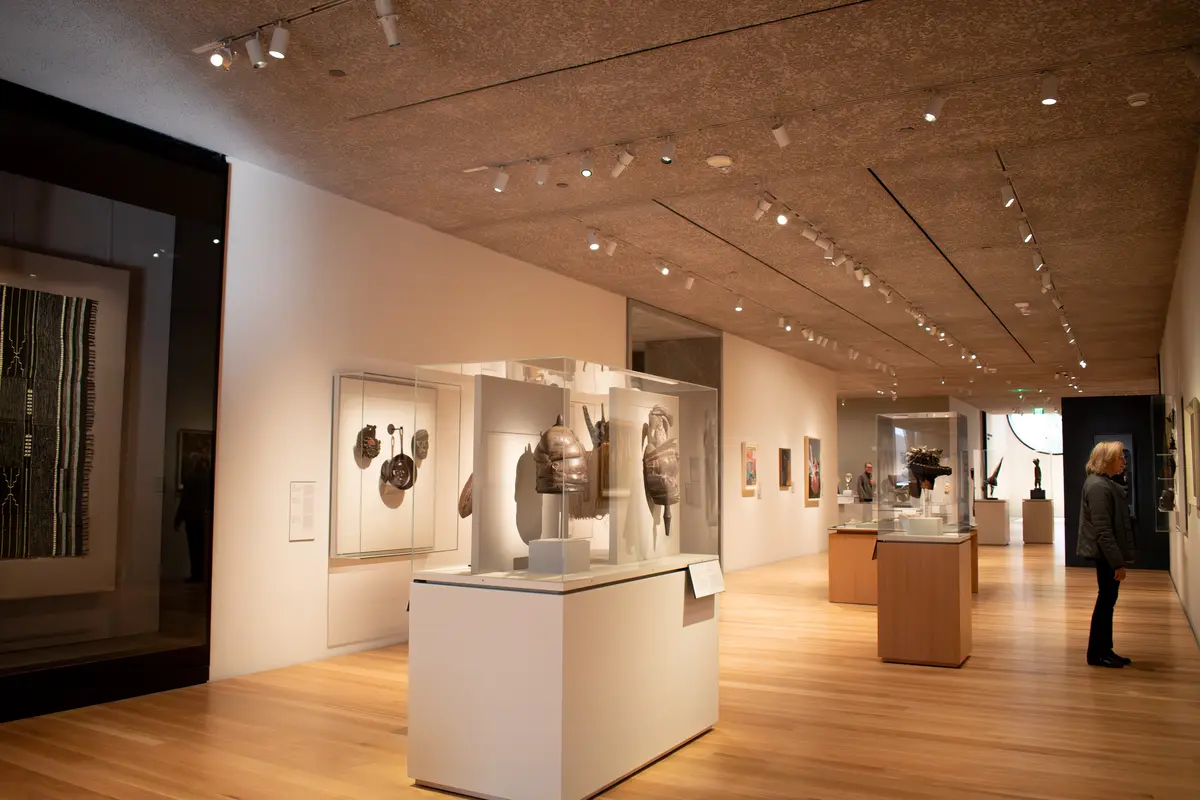
6–7 a.m.
6:00 a.m. — The Art Museum is awake and noisy,
deceivingly so in the sleepy early morning.
Behind the information desk, two women discuss
trick-or-treating. Museumgoer couples descend
the grand staircase. A student stands a bit
too close to a Frank Stella oil painting. Even
laughter from two PSafe officers reverberates
in the open, well-lit space.
6:08 a.m. — I come across Marilyn Simeone, who
was a program manager in the University’s
Campus Interiors in Facilities, and local
resident Anne Wright Wilson craning their
necks up at a fragment of a limestone stairway
in the entrance hall. They’ve been in the
Museum since 5:08 a.m. “We wanted to come to
see [the museum] when it was open before it
became public,” Simeone says. “It’s nice when
it’s quiet.”
6:10 a.m. — Just had a lovely chat with
Rutgers professor Anita Franzione. She woke up
at 4 a.m. for her usual run, then decided to
visit the art museum. She wanted “to be here
at night, [at] a time that is abnormal to see
art.” “I’ve been coming to the Princeton
museum with my children since forever,”
Franzione says. “[It’s] a little overwhelming
compared to what it was … but I think it’s
just amazing.”
6:11 a.m. — A young PSafe officer on the
second floor of the Orientation Gallery squats
down, relieving his fatigued legs from
standing for too long.
6:19 a.m. — There’s one last remaining group
of students here from their night out.
6:44 a.m. — The sky is a blend of deep purples
and blues. The South Terrace view, overlooking
the lawn of Prospect House, features a group
of runners clad in black athleisure,
stretching and warming their muscles.
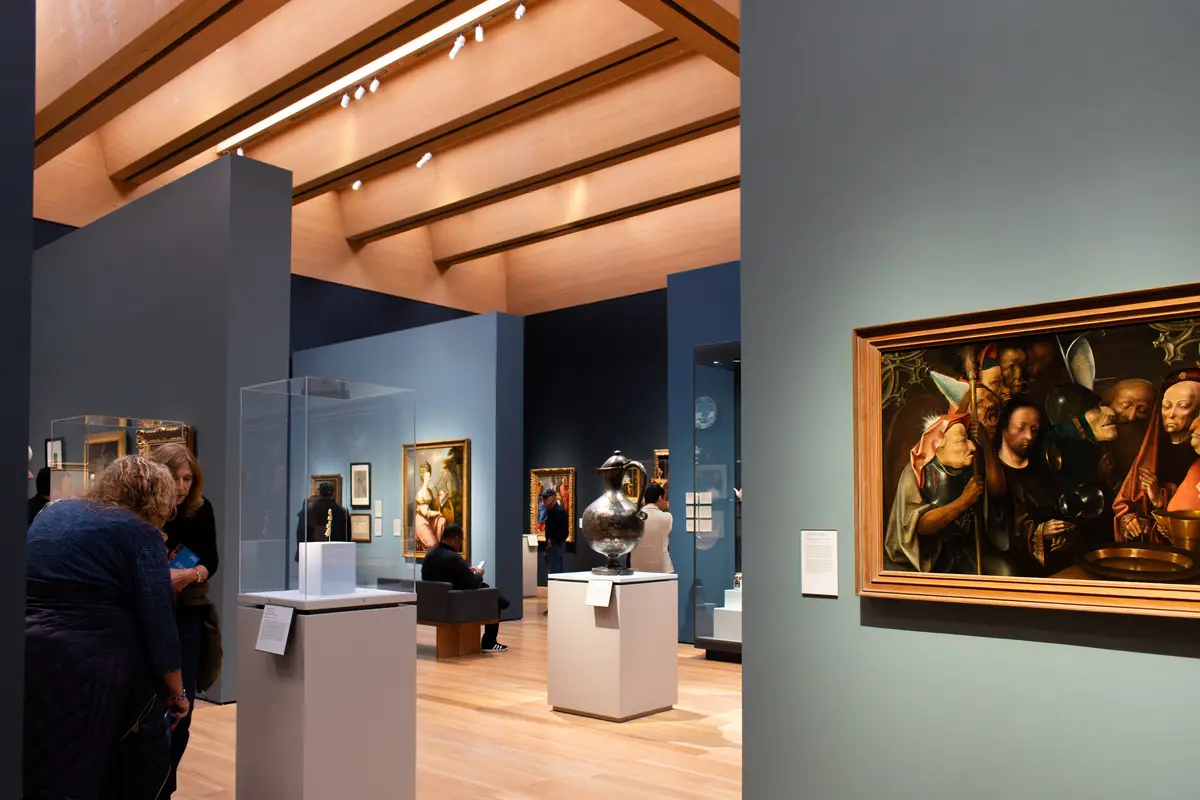
7–8 a.m.
7:15 a.m. — It turns out that there is no
ideal position in the art museum from which to
view the sunrise. This feels like an
oversight. But standing on the east terrace
and gazing in the direction of Prospect House,
one can at least see the sky gradually
lighten.
7:23 a.m. — It turns out that the Stacey &
Robert George viewing room is the best room
from which to view the sunrise. The sun sends
orange shafts into the room. Still, the blinds
close automatically at 7:27 a.m., so the
viewing-window was brief.
7:42 a.m. — In the Creativity Labs, a few
parents and their children browse the
collection of possible mediums. They appear to
debate between markers and crayons.
7:50 a.m. — Courtney Matlock, who works in
development on the fundraising side, says that
the team has expanded over the last two years,
and most of the heavy lifting for fundraising
is behind them, as the art museum is
completed. Now, Matlock’s goal is to
diversify. “Every nonprofit needs to diversify
supporters,” she explains. “It’s a teaching
museum, so letting the community know that it
is open to them and that it is a free museum
is a really intentional draw.” Matlock’s
favorite piece so far is the Nick Cave “Let me
kindly introduce myself. They call me MC
Prince Brighton,” (2025). She saw the artist
the previous night. “I don’t get star struck,
but I was star struck,” she says.
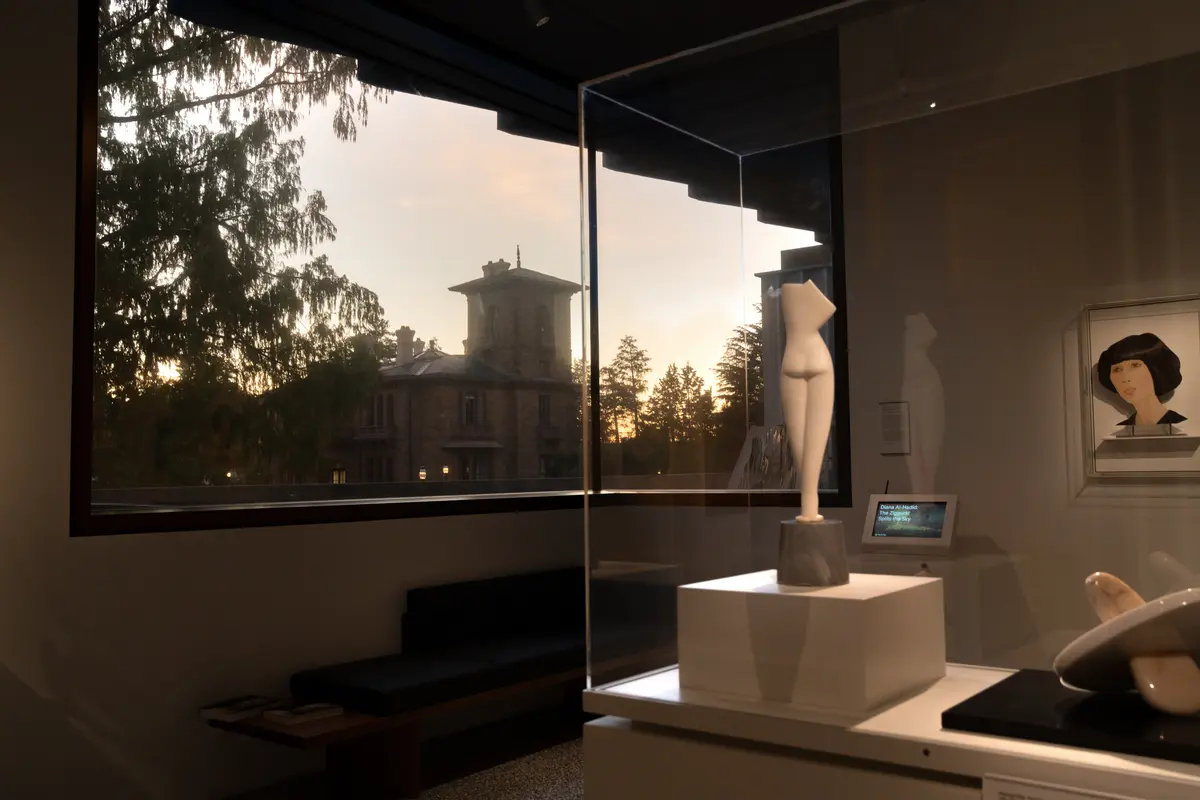
8–9 a.m.
8 a.m. — Yoga time! Around 19 people, mostly
on the older side, sprawl out on yoga mats on
the side of the museum that faces Prospect
House. The practice is led by Debbi Gitterman,
a spritely woman clad in black athleticware.
“Thank you to the brave souls who thought yoga
at 8 a.m. in 40 degree weather was a good
idea,” she says.
8:23 a.m. — Gitterman urges us not to be too
concerned with the perfection of the shapes
our bodies make. “What you do is correct. What
you feel is correct. You’re already perfect,”
she assures us. Which is exactly what I need
to hear when I fall out of my downward dog.
8:43 a.m. — Gitterman instructs us to add a
delightful hop in our routine: “When do we get
to skip these days?” She reiterates that it’s
entirely up to us if we do, although everyone
follows suit. The air fills with the sound of
shoes lightly bouncing on silicon mats.
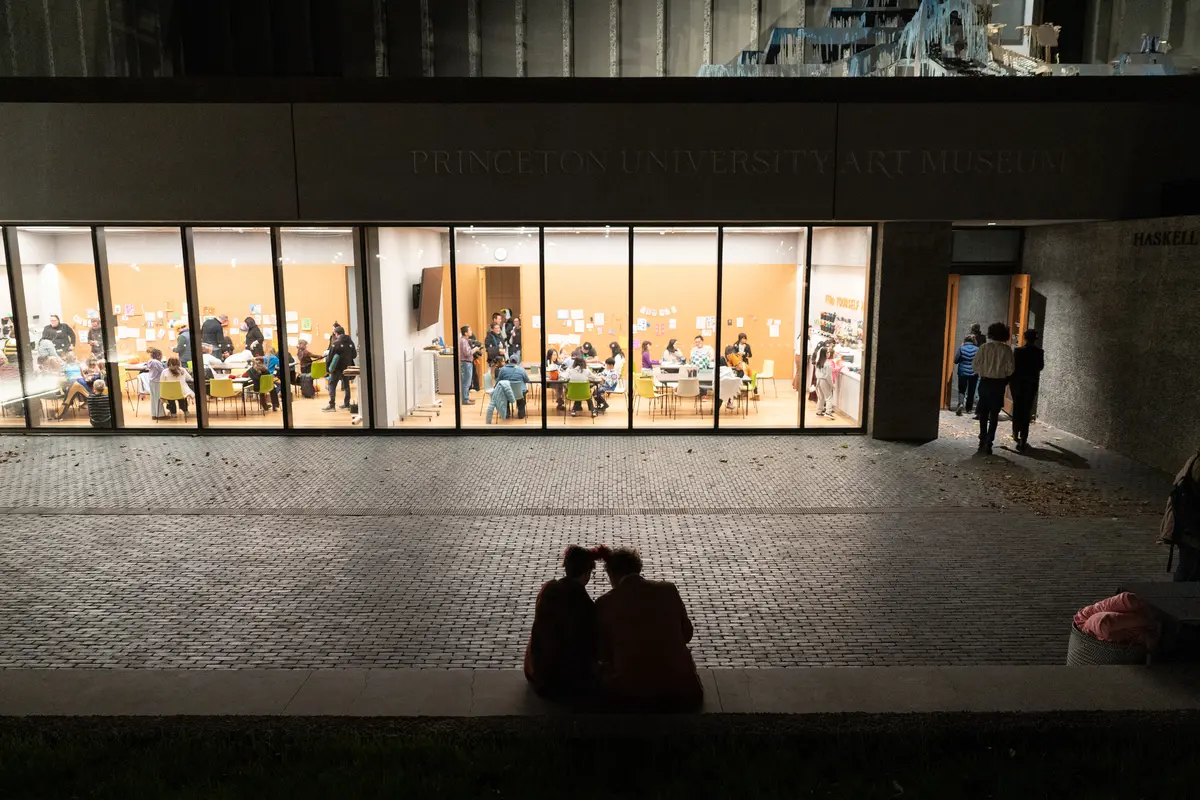
9–10 a.m.
9 a.m. — Workers pull back a metal curtain to
open up the Museum Store. People mill about
and examine wooden wands, intricate spoons,
and very tempting notebooks.
9:05 a.m. — The meditation session is full! I
ask if I can enter just to observe, but the
guards at the door tell me that they have been
working to “create an atmosphere of complete
silence” for the last 35 minutes, so I cannot
enter.
9:41 a.m. — The Mosaic workers, circled up
with notepads, are having a morning meeting.
Someone wanders into the restaurant anyway,
just to check it out. His companion calls him
back, pointing to the window across from
Mosaic and exclaiming, “Get out of there, you
can see the Nick Cave from up here, look!”
9:44 a.m. — If I can’t get into the meditation
session itself, I might as well spy on it from
the Art of the Ancient Americas pavilion
above. I look down to discover 120 people
peacefully seated in concentric circles, with
musicians playing live music in the middle.
9:49 a.m. — I catch a woman named Mimi Deitsch
on her way out from meditation. “Sorry, I’m
still a bit zenned out,” she says. She’s done
this before in Richardson and really enjoys
it. “With the music in the middle, it’s
something magical,” she explains. “It brought
tears to my eyes.”
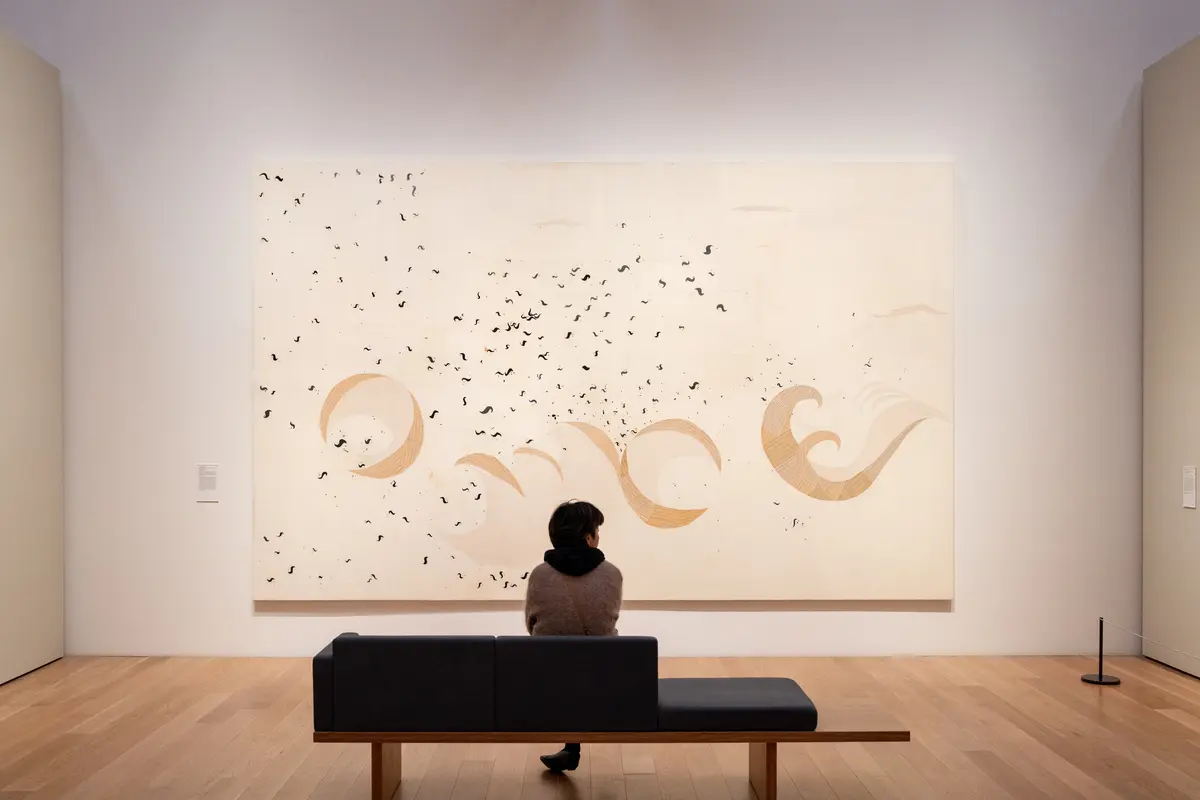
10–11 a.m.
10:11 a.m. — “It’s so many people!” remarks a
woman walking down the stairs to the first
floor. She’s correct, but there’s a
particularly noticeable population of families
with small children. Everywhere you look,
there’s a double stroller.
10:27 a.m. — Mosaic is nearly at capacity,
with couples and friends ready to brunch.
10:30 a.m. — Bernard Miller, from the
Princeton area, is here in a kilt. “It was
just a perfect day, not too hot, not too cold.
So I thought I’d just wear my kilt,” he says.
10:52 a.m. — Just outside the Modern and
Contemporary Art pavilion, longtime Princeton
resident Ellen Roffis says she and her husband
have been counting down the days until the
museum’s opening, but they decided to wait a
few extra hours before taking their visit. “We
knew it would be open all night, but we’re too
old for that,” Roffis says.
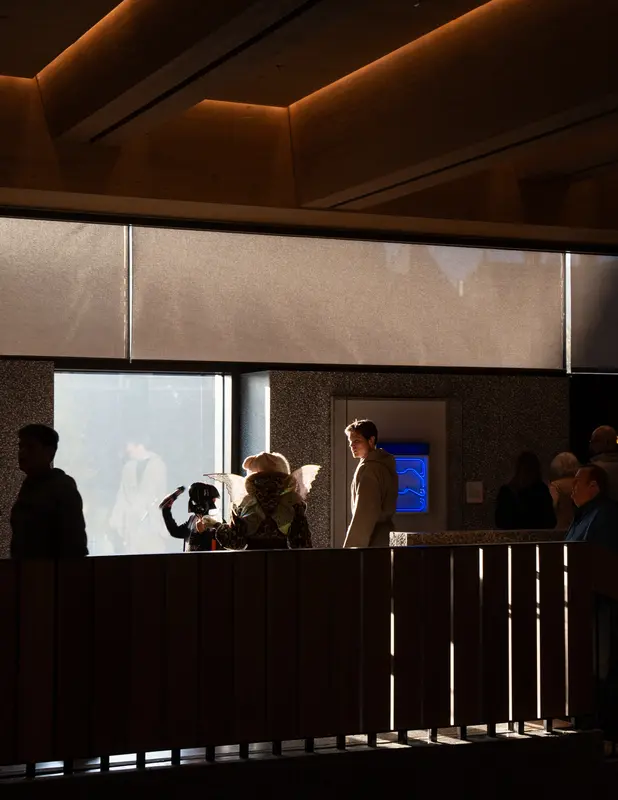
11 a.m.–12 p.m.
11:01 a.m. — The lobby is buzzing with
activity as parents, children, older couples,
and students make their way towards the Grand
Hall and upward towards the several pavilions.
11:07 a.m. — On the second floor, it seems
nearly every painting is swarmed by someone
gazing and thoughtfully reading the works’
inscriptions.
11:12 a.m. — At “Storytime at the Galleries,”
an older museum worker dressed in a blazer
reads to a room full of children. The children
watch intently as the woman interacts with her
audience. She asks them brightly: “Do you know
what a compliment is?” before inviting every
child to give someone else a compliment.
11:47 a.m. — Passing priceless Roman
artifacts, I hear a father pleadingly remind
his child, “We’re just looking, honey … we’re
just looking.”
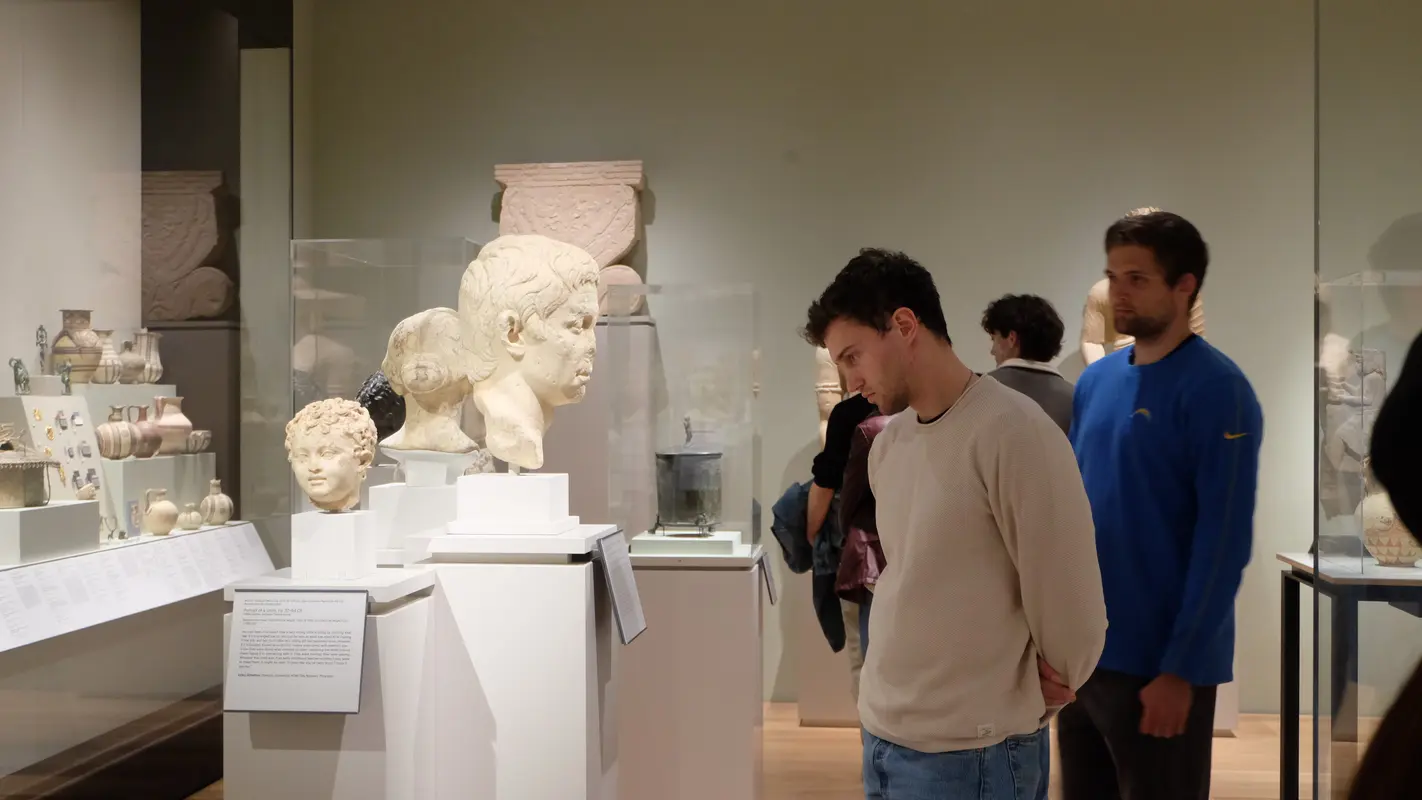
12–1 p.m.
12:01 p.m. — Members of the Westrick Boychoir
Young Men’s Ensemble and Girlchoir Ensemble
start singing in Tuttle Lecture Hall, which is
filled to the brim. Many audience members are
left standing to the sides of the room, and
about a dozen more are listening in from
outside.
12:25 p.m. — Several children are still
dressed in Halloween costumes; as I listen in
on the choir in Tuttle Hall, I spot a cat
costume and a wailing child in a police
outfit.
12:32 p.m. — Sabrina Yeung ’26 brought her
mother, Mei, who is visiting for the weekend,
to visit the new museum. “It reminds me of the
Met,” she says, and her mother, who visited
the pre-construction museum, agreed. “This is
huge in comparison with the old one,” Mei
says. They’ve only seen a couple of galleries
so far and are particularly excited to see
Monet’s “Water Lilies and Japanese Bridge.”
12:33 p.m. — Next to the Tuttle Lecture Hall,
the museum’s newest art-making spaces are
bustling with children cutting colored paper
for a suncatcher activity led by Estefany
Rodriguez-Morrison, the supervisor for the
Creativity Labs. “This space is really about
finding like-minded people, combating
loneliness, mental health, and discovering
your inner child,” Rodriguez-Morrison, who has
been supervising the labs since 9 a.m., tells
me. “This is a place for all ages, and we will
have programming for K–12.”
12:58 p.m. — Over 250 people sit in the Grand
Hall awaiting “The Art of a Song: A Broadway
Cabaret,” which features Tony-nominated singer
and actress Kate Baldwin and lecturer Georgia
Stitt. The glass walls of the hall give me a
glimpse of the Greek vases on the second
floor.
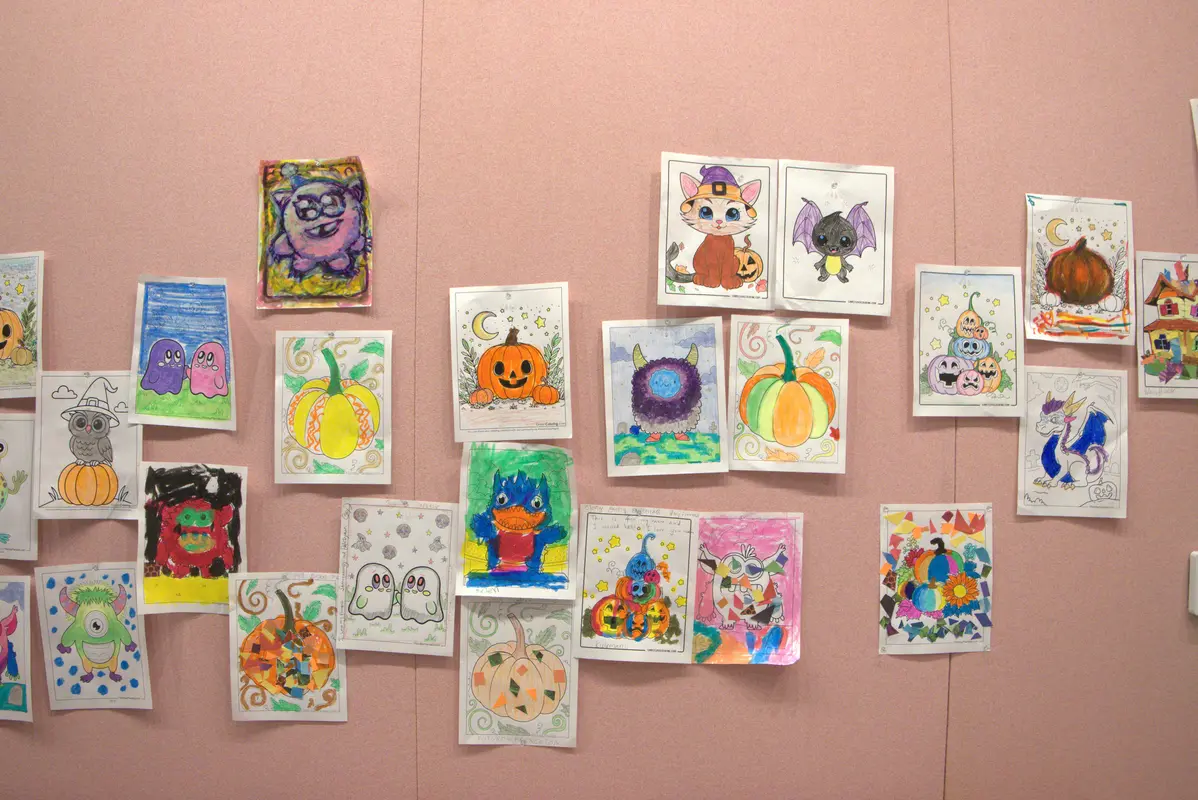
1–2 p.m.
1:03 p.m. — Steward takes the stage, revealing
that the museum attracted 16,638 visitors as
of noon. “We began brainstorming about the
kinds of performances and programs that could
work best in our new spaces, and the kinds of
talent we would want to platform. The
incredible duo we’re about to hear was top of
the list for us,” he tells the audience.
1:07 p.m. — The show kicks off. “Art is
something that you do, something that you
make, something you can show to the world,”
Baldwin sings. Stitt accompanies her on piano,
and the duo play through a set of songs
related to art-making and the creative
process.
1:21 p.m. — Stitt offers the audience a taste
of her upcoming album, parts of which were
inspired by “Poetry in Motion” printed on the
New York City Transit subways. The audience
laughs along as Stitt and Baldwin sing about
bee killers, hunger, and romantic betrayal.
1:58 p.m. — The performance is greeted by a
standing ovation. “It seemed like everybody
was really engaged in the performance,” Anna
Villegas, the Presented Programming Manager at
McCarter Theatre Center, says. “The performers
did such an amazing job relating their subject
matter and their song choices to the art
museum and the creative process.”
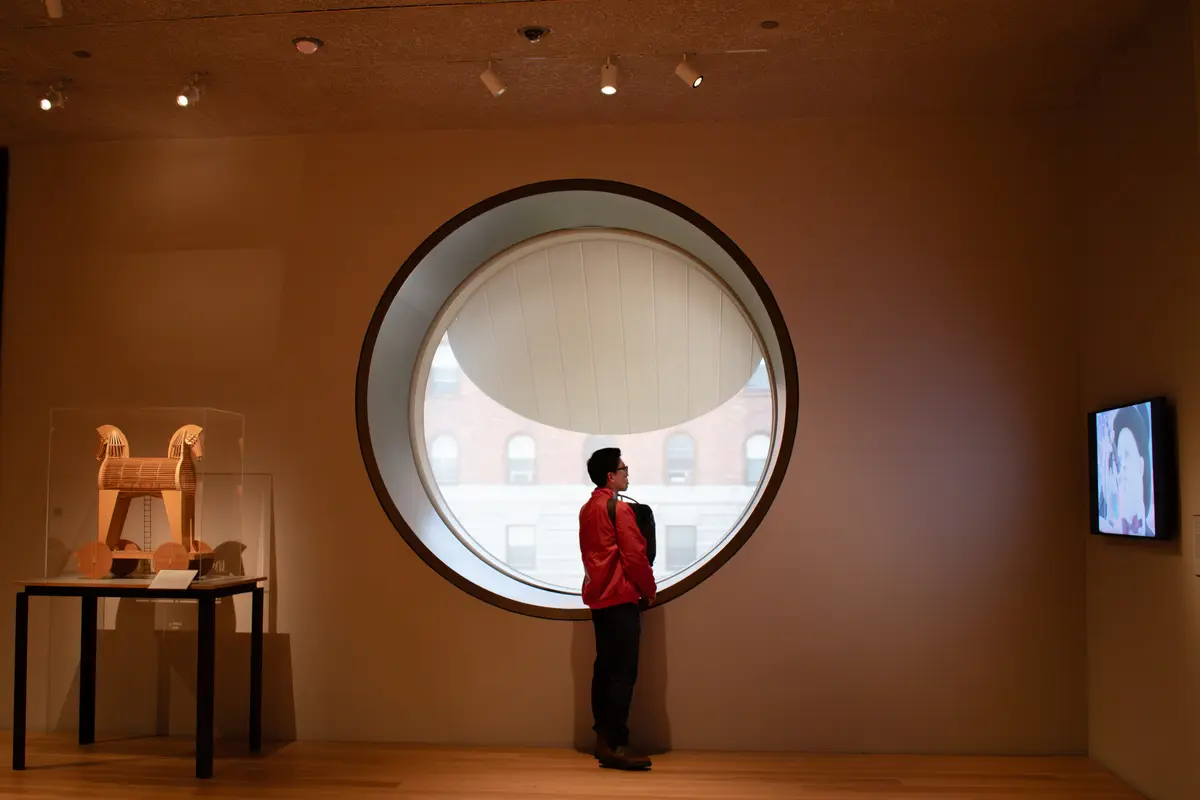
2–3 p.m.
2 p.m. — At the Jhumpa Lahiri reading in
Tuttle Lecture Hall, people filter in. The
crowd is overwhelmingly skewed older. The
event wasn’t explicitly advertised to
students, and many students told me afterward
they would’ve loved to come if they had known
about it.
2:08 p.m. — In the wait line, I speak with
Barry Wechsler ’73, the former photography
chair of the ‘Prince,’ and his wife, Carol
Yoshimine, Professor of Fine Arts emerita at
Centenary University. “As soon as I saw [an
email about the event], I went on to try to
register for Jhumpa Lahiri,” Wechsler says.
“It was already sold out. Like, within the
first few hours — may have even been the first
few minutes.”
2:14 p.m. — Lahiri begins speaking. She
describes how important the old art museum was
to her when she taught at Princeton. “It was
really my point of reference, refuge,” she
says. “I just found it always to be the most
comforting and welcoming place.”
2:35 p.m. — Lahiri moves on to reading
previously unheard passages from her
forthcoming translation of Ovid’s
“Metamorphoses,” co-written with Princeton
Classics professor Yelena Baraz. She says this
is her first time presenting the work, and is
visibly working out the flow of the lines as
she goes.
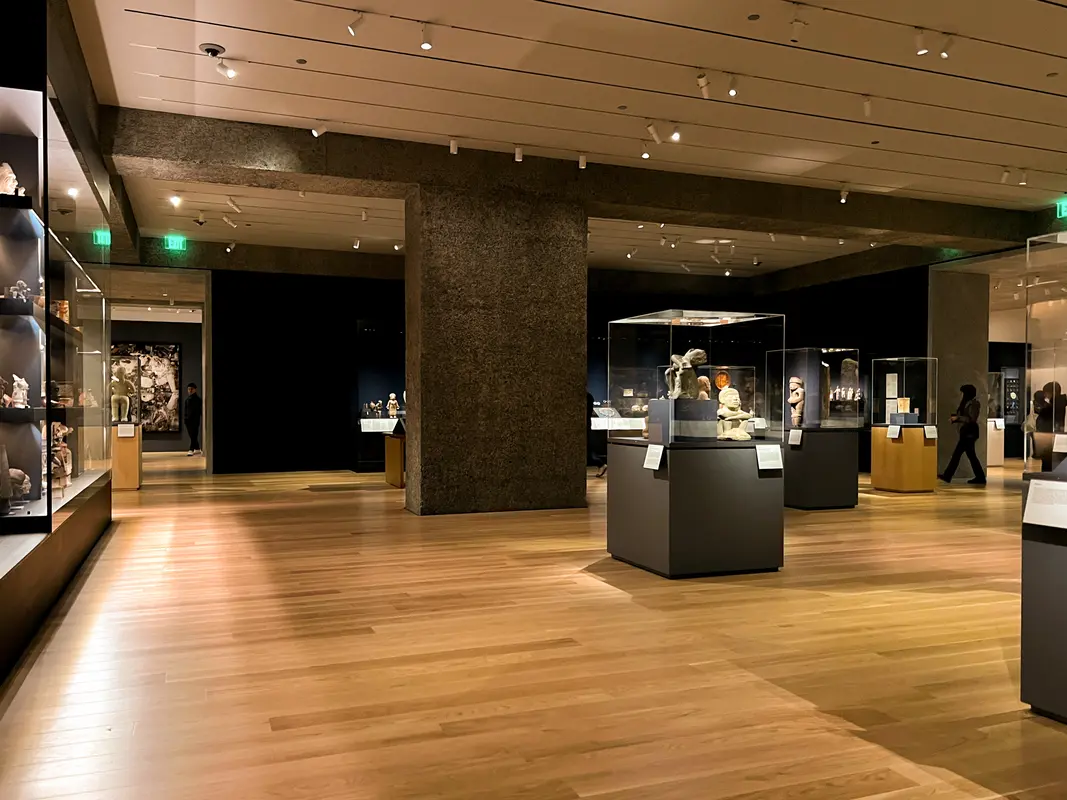
3–4 p.m.
3:10 p.m. — A crowd gathers in the
Conservation Studios, with people reaching
over the group to photograph the equipment and
hear from the chief conservator, as will
happen every month.
3:15 p.m. — A group gathered around all sides
of “Idiot Strings” discusses the rig
supporting the art, interested in the
mechanics of the display.
3:26 p.m. — In the gallery with the Monet,
PSafe seems more on alert, instructing
onlookers to cease leaning on tables and to
place backpacks on one shoulder or in front of
them — including me!.
3:32 p.m. — To exit to the sculpture garden on
the east terrace, almost everyone seems to
comment on the difficulty of opening the
doors.
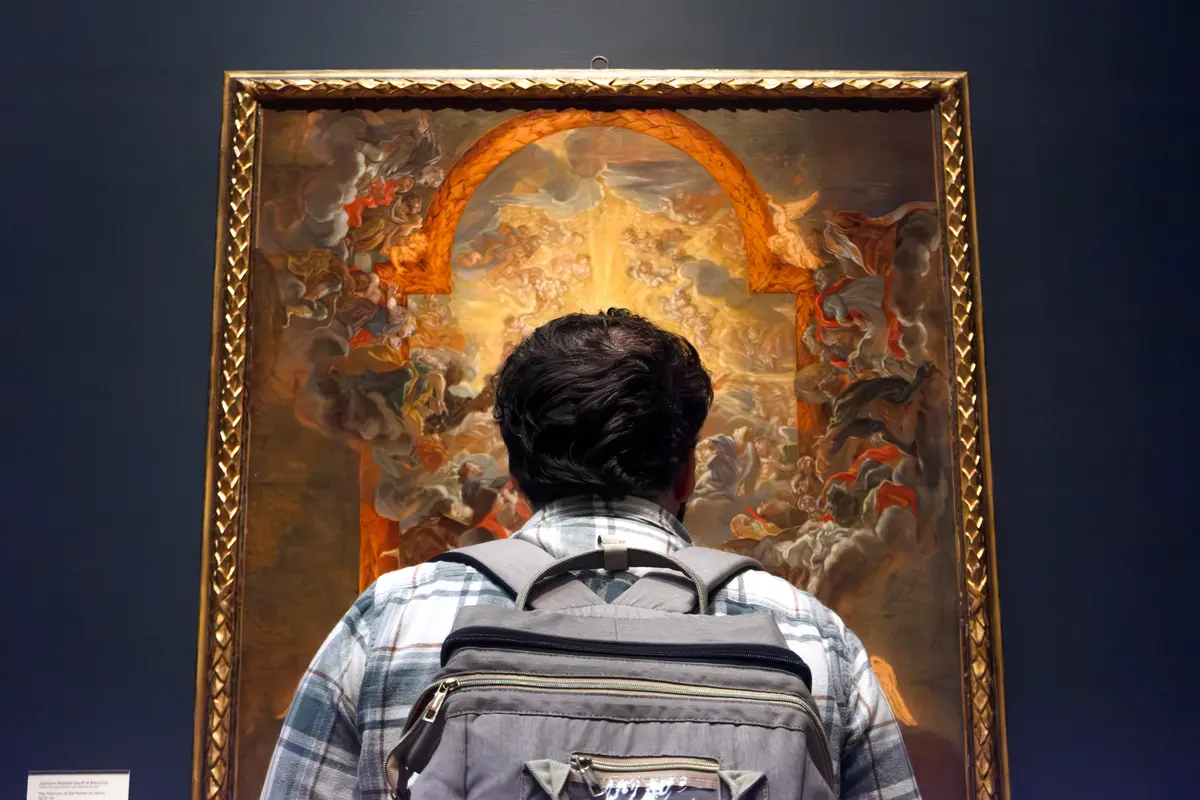
4–5 p.m.
4 p.m. — This is the final hour. Crowds remain
throughout the museum — a mix of students,
alumni, and townspeople. The Grand Hall is
closed for “The Art of the Moth: A
Storytelling Salon.”
4:30 p.m. — It’s still busier than I expected.
The museum store is popping, and people seem
to be flooding down the stairs.
4:36 p.m. — I overhear a conversation between
a couple of students talking about writing
their senior theses and how the piece
“America” by Hugh Hayden could be used as an
example of the perversion of the American
Dream.
4:45 p.m. — A bell rings; “The galleries will
be closing in 15 minutes.” When I come back
down to the ground floor, I speak to Irene
Osted, an artist in Princeton. She appreciates
the integration of art into the design of the
museum. “I think this idea is unique with
having you walk on the ancient tiles over
glass, like they did in those days,” Osted
says.
4:46 p.m. — I find Steward again. He’s been
here for over 14 hours of the open house.
“It’s just so heartwarming to see that people
have wanted to be part of this,” Steward says.
He was here at 1:30 a.m. introducing a movie
and was delighted to see so many people still
at the museum at that time. “Whether you’re a
student living in the dorm next door, or
someone living in the next county, [I hope]
that we become a place that you can seek out
when you want to be inspired or reminded that
life can be okay,” Steward concludes.
4:58 p.m. — The Moth event finishes. The Grand
Hall empties. David Hassett and Catherine
Talton found the storytelling "very natural"
and "incredibly relatable."
5 p.m. — That is it. 24 hours in the art
museum are over. The bell rings and the
galleries close. "Please make your way
immediately towards the first floor exits."
